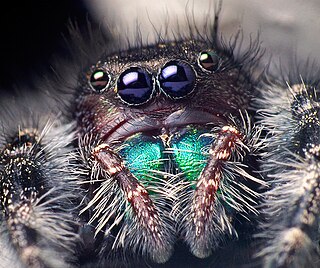
The large tortoiseshell or blackleg tortoiseshell is a butterfly of the family Nymphalidae.

Phidippus is a genus in the family Salticidae. Some of the largest jumping spiders inhabit this genus, and many species are characterized by their brilliant, iridescent green chelicerae. Phidippus is distributed almost exclusively in North America, with the exception of two exported species. As of January 2021, there were about 80 described species in the genus. Species previously described in Phidippus which are found in India and Bangladesh do not belong in this genus.

The queen butterfly is a North and South American butterfly in the family Nymphalidae with a wingspan of 80–85 mm. It is orange or brown with black wing borders and small white forewing spots on its dorsal wing surface, and reddish ventral wing surface fairly similar to the dorsal surface. The ventral hindwings have black veins and small white spots in a black border. The male has a black androconial scent patch on its dorsal hindwings. It can be found in meadows, fields, marshes, deserts, and at the edges of forests.

The red-banded hairstreak is a butterfly native to the southeastern United States. It feeds on fallen leaves of sumac species and other trees. Its size ranges from 0.9–1.25 inches (23–32 mm). It lives near coastal areas.

Phidippus audax, the bold jumper or bold jumping spider, is a common species of spider belonging to the genus Phidippus, a group of jumping spiders easily identified by their large eyes and their iridescent chelicerae. Like all jumping spiders, they have excellent stereoscopic vision that aids them in stalking prey and facilitates visual communication with potential mates during courting. Bold jumping spiders are native to North America and have been introduced to Hawaii, Nicobar Islands, Azores, and the Netherlands. They are typically black with a distinct white triangle on their abdomen.

Mopsus mormon is an Australian spider species of the family Salticidae. It is the sole species in the genus Mopsus. It is found in New Guinea and eastern Australia. It is commonly called the green jumping spider.

Phidippus californicus is a species of jumping spider. It is found in the southwestern United States and northern Mexico.

Amathusia phidippus, the palmking, is a butterfly found in India and Southeast Asia. It belongs to the Satyrinae, a subfamily of the brush-footed butterflies.

Amathuxidia amythaon, the koh-i-noor, is a butterfly found in Asia. It belongs to the Morphinae, a subfamily of the brush-footed butterflies.
Amathusia andamanensis, the Andaman palmking, is an endemic butterfly found in India that belongs to the Morphinae subfamily of the brush-footed butterflies family.

Phidippus otiosus is a species of jumping spider that is found in southeastern North America. It is primarily a tree-living species. Females reach a body length of about 16 mm. Its iridescent chelicerae can range in color from purple to green.

Amathusiini is a tribe of the nymphalid butterfly subfamily Morphinae. They are large butterflies. They are sometimes treated as a distinct subfamily Amathusiinae or family Amathusiidae.

Hair-pencils and coremata are pheromone signaling structures present in lepidopteran males. Males use hair-pencils in courtship behaviors with females. The pheromones they excrete serve as both aphrodisiacs and tranquilizers to females as well as repellents to conspecific males. Hair-pencil glands are stored inside the male until courtship begins, at which point they are forced out of the body by sclerotized levers present on the abdomen. Coremata are very similar structures. Their exact definition is confused by early descriptions but they are more specifically defined as the internal, glandular, eversible structures that bear the hair-pencils and can be voluntarily inflated with hemolymph or air.

Amathusia is a genus of large forest butterflies with "wingtails" in the family Nymphalidae. They are known as the palmkings and the larvae feed on palms (Arecaceae). Amathusia ranges from the Andaman Islands to Sulawesi.
Amathusia binghami is a butterfly found in Peninsular Malaya and Sumatra It belongs to the Satyrinae, a subfamily of the brush-footed butterflies.
Amathusia friderici, commonly known as bicolor-haired palmking, is a butterfly found in the Indomalayan realm It belongs to the Satyrinae, a subfamily of the brush-footed butterflies.

Amathusia masina, the rusty palmking, is a butterfly found in the Indomalayan realm It belongs to the Satyrinae, a subfamily of the brush-footed butterflies.

Amathusia schoenbergi , the scalling palmking, is a butterfly found in the Indomalayan realm It belongs to the Satyrinae, a subfamily of the brush-footed butterflies.

Amathusia ochraceofusca , the pale-haired palmking, is a butterfly found in the Indomalayan realm It belongs to the Satyrinae, a subfamily of the brush-footed butterflies.














